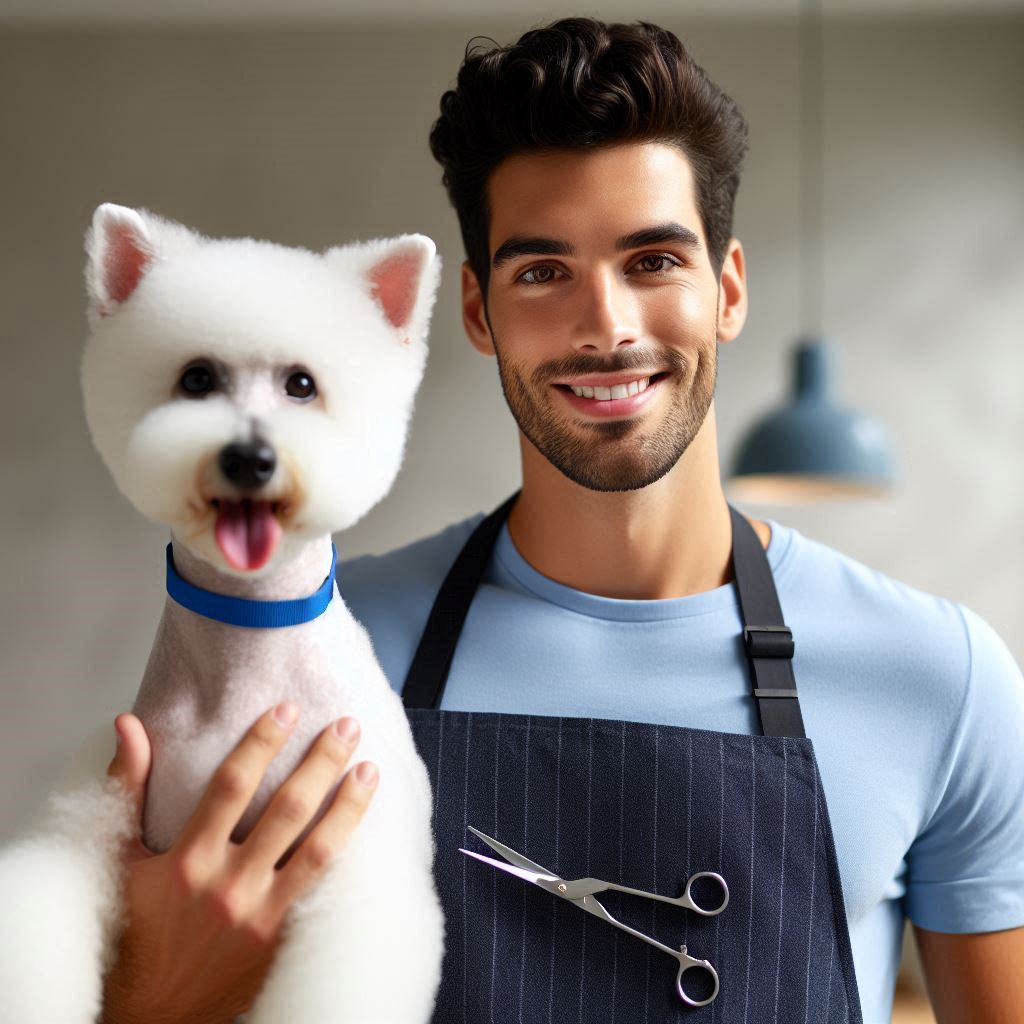Introduction
A day in the life of a professional pet groomer is full of activity and responsibility.
Groomers play a vital role in keeping pets healthy and happy.
Regular grooming improves the pet’s appearance, comfort, and overall well-being.
It also helps prevent health issues like skin infections, matting, and overgrown nails.
Pet grooming requires a variety of skills and attention to detail.
Groomers not only wash, clip, and style pets but also check for any signs of health concerns.
They handle pets of all sizes and temperaments, which can be challenging yet rewarding.
Proper grooming helps to identify health problems early, ensuring pets receive timely care.
In this post, we will explore the different tasks and responsibilities that pet groomers handle daily.
From bathing and brushing to nail trimming and ear cleaning, a groomer’s work is detailed and essential.
We will also touch on the importance of maintaining a safe and calming environment for both the pets and the groomer.
Each day brings unique challenges, but the results are worth it.
Groomers take pride in ensuring every pet looks and feels its best.
Morning Routine
Typical morning routine of a professional pet groomer
A professional pet groomer typically starts their day early, usually around 8 AM.
They begin by organizing their grooming tools, making sure everything is clean and in good working condition.
Setting up the grooming area involves laying out towels, brushes, shampoos, and other products needed for the day.
The groomer also checks their appointment book to see what pets are scheduled for grooming that day.
Importance of a clean and organized workspace for pet grooming
A clean and organized workspace is essential for pet grooming to ensure the safety and comfort of the pets.
Before the first appointment arrives, the groomer takes a few moments to mentally prepare for the day ahead.
Greeting each pet with a calm and friendly demeanor sets the tone for a positive grooming experience.
Transform Your Career Today
Unlock a personalized career strategy that drives real results. Get tailored advice and a roadmap designed just for you.
Start NowThroughout the morning, the groomer focuses on providing individualized care and attention to each pet.
Communicating with pet owners about their preferences and any specific concerns is also a crucial part of the morning routine.
Read: How to Balance Work and Personal Life in Childcare
Client Consultations
During client consultations, pet groomers take the time to listen to the needs and preferences of pet owners to ensure that their furry friends receive the best care possible.
This step is crucial in understanding the specific requirements of each pet and how groomers can meet those needs effectively.
Process of Client Consultations
When a pet owner schedules an appointment for grooming, the groomer usually begins by welcoming them and their pet into the salon or grooming facility.
The groomer then sits down with the client to discuss their expectations, any specific requests they may have, and the condition of the pet’s coat and skin.
During this time, it is important for groomers to ask questions to better understand the pet’s grooming history, any sensitivities or allergies they may have, and the overall health and temperament of the pet.
Assessing Needs and Preferences
Pet groomers assess the needs of pet owners by carefully observing the pet’s behavior, coat condition, and any visible skin issues.
They also take note of the pet owner’s preferences, such as the desired length of the pet’s coat, specific styling requests, or any particular grooming products they prefer or avoid.
By understanding both the pet’s needs and the owner’s preferences, groomers can tailor their grooming services to provide a customized experience for each pet.
Common Requests and Concerns
One common request from pet owners is to have their pet’s coat trimmed to a certain length, especially during the warmer months to keep them cool.
Some pet owners may express concerns about matting or tangles in their pet’s coat, which can be addressed during the grooming process.
Others may have specific requests for nail trimming, ear cleaning, or teeth brushing to ensure their pet’s overall health and well-being.
Overall, client consultations are an important step in the grooming process as they allow pet groomers to establish a relationship with pet owners, understand their preferences, and provide the best possible care for their furry companions.
Pet Handling and Safety
Importance of proper pet handling and safety measures during grooming
Proper pet handling and safety measures are essential during grooming sessions.
Groomers need to ensure the pet’s comfort while keeping themselves safe.
Handling pets with care builds trust, reducing stress for both the animal and the groomer.
Calm handling prevents injuries, making the grooming experience smoother for everyone involved.
Techniques for calming and restraining pets during the grooming process
To calm pets, groomers often use soothing voices and gentle touch.
These techniques help pets relax, especially those new to grooming.
Some groomers may allow the pet to sniff grooming tools to ease anxiety.
These small actions create a calming environment that can make a significant difference during the session.
The use of safety equipment
Safety equipment, such as muzzles and restraints, plays a key role in preventing accidents.
Muzzles are useful for aggressive or anxious pets, while restraints secure animals in place during grooming.
These tools are used responsibly, ensuring that pets are safe but not uncomfortable.
Safety equipment also protects groomers from potential bites or scratches.
By following proper handling techniques and using safety equipment, groomers create a safe environment for both the pets and themselves.
Calm pets are easier to groom, reducing the likelihood of accidents.
Effective safety measures ensure a smooth grooming process, which builds a positive experience for the pet, the groomer, and the pet owner.
In fact, proper pet handling and safety are critical in pet grooming.
Groomers must use calming techniques and safety equipment to ensure a safe, stress-free experience for all.
Prioritizing safety allows for better grooming outcomes and happier, healthier pets.
Read: Best Pet Grooming Schools in the United States
Grooming Process
Steps Involved in the Grooming Process
- Bathing: Begin by thoroughly wetting the pet’s coat and using a gentle pet shampoo.
- Brushing: Remove any tangles or mats from the fur before proceeding with the grooming.
- Trimming: Use appropriate scissors or clippers to trim the pet’s coat to the desired length.
- Nail Trimming: Trim the pet’s nails carefully to prevent discomfort and maintain paw health.
- Ear Cleaning: Clean the pet’s ears with a pet-safe solution to prevent infections.
- Styling: Finish off with styling, such as shaping the coat or adding bows for a cute look.
Importance of Using Appropriate Grooming Products
- Different pet breeds and coat types require specific grooming products for optimal results.
- Using the wrong products can cause skin irritation, dryness, or damage to the pet’s coat.
- Consult with a professional groomer to determine the best products for your pet’s needs.
Tips for Handling Grooming Challenges
- Matting: Use a detangling spray and a comb to gently remove mats without causing pain.
- Shedding: Regular brushing and deshedding tools can help minimize shedding and keep the coat healthy.
- Sensitive Skin: Use hypoallergenic grooming products to prevent skin irritation and discomfort.
Specialized Services
Professional pet groomers offer a variety of specialized grooming services to cater to the unique needs of different pets.
These services go beyond just a simple bath and haircut and focus on specific areas of grooming that are essential for the overall health and appearance of pets.
Nail Trimming
Nail trimming is an important part of pet grooming that helps to prevent overgrowth and breakage of nails.
Professional pet groomers are skilled in safely trimming nails to the appropriate length without causing any discomfort to the pet.
Regular nail trimming also helps to prevent issues such as ingrown nails and infections that can arise from long or sharp nails.
Teeth Cleaning
Teeth cleaning is another specialized service offered by professional pet groomers to maintain the oral hygiene of pets.
Groomers use pet-friendly toothbrushes and toothpaste to gently clean the teeth and gums of the pets.
Regular teeth cleaning can prevent dental issues such as plaque buildup, cavities, and gum disease, ensuring overall oral health.
Ear Care
Ear care is an essential part of grooming, as pets are prone to ear infections and ear mites.
Professional pet groomers use specialized ear cleaning solutions and techniques to safely clean the pet’s ears.
Proper ear care can prevent issues such as wax buildup, infections, and discomfort for the pet.
Overall, specialized grooming services offered by professional pet groomers play a crucial role in maintaining the health and appearance of pets.
These services go beyond the basics of grooming and focus on specific areas that require expertise and attention to detail.
By availing of these specialized services, pet owners can ensure that their pets are well-groomed, healthy, and happy.
Read: Educational Requirements for Childcare Workers Explained

Handling Difficult Pets
Grooming difficult pets can be a challenge for professional pet groomers.
Aggressive pets may require special handling techniques to ensure safety for both the groomer and the pet.
It’s important to approach anxious or behaviorally challenged pets with patience and understanding.
Building trust with difficult pets takes time and consistency in your interactions with them.
Here are some strategies for safely and effectively grooming difficult pets:
Safety First
- Always prioritize safety when dealing with aggressive or anxious pets.
- Use muzzles, grooming restraints, or calming techniques to ensure a secure grooming environment.
- Consider using a grooming table with secure restraints for added safety during the grooming process.
Patience and Understanding
- Approach difficult pets with a calm and patient demeanor to help alleviate their anxiety.
- Take breaks during the grooming process if the pet becomes too stressed or agitated.
- Understand that some pets may have had negative experiences with grooming in the past, causing their fear or aggression.
Positive Reinforcement
- Use treats, praise, and rewards to encourage good behavior during the grooming session.
- Reward small victories, such as allowing you to touch a sensitive area or stand still for grooming.
- Positive reinforcement helps build trust and create a more positive grooming experience for the pet.
Desensitization Techniques
- Gradually introduce the pet to grooming tools and equipment to desensitize them to the process.
- Start with short grooming sessions and gradually increase the length as the pet becomes more comfortable.
- Use gentle handling and positive reinforcement to help the pet associate grooming with a positive experience.
Professional Training and Support
- Seek out professional training or support if you encounter a particularly difficult pet.
- Consider working with a behaviorist or trainer to address underlying behavior issues.
- Continued education and training can help groomers develop the skills necessary to handle challenging pets effectively.
Building Trust and Rapport
- Spend time getting to know the pet outside of grooming sessions to build trust and rapport.
- Use a soft voice, gentle touch, and positive reinforcement to create a bond with the pet.
- Consistency and patience are key to developing a positive relationship with difficult pets over time.
By implementing these strategies and techniques, professional pet groomers can effectively handle difficult or aggressive pets while ensuring their safety and well-being during the grooming process.
Building trust and rapport with challenging pets takes time and dedication, but the rewards of a positive grooming experience for both the pet and the groomer are well worth the effort.
Read: Top Certifications for Advancing in Childcare Careers
Client Communication
Effective communication with pet owners is crucial for pet groomers to ensure the best care for their furry clients.
Here’s how pet groomers handle client communication:
Keeping Pet Owners Informed
Groomers provide detailed explanations of the grooming process to pet owners before starting.
They discuss the expected outcomes based on the pet’s breed, coat condition, and specific needs.
Regular updates are given during the grooming session to keep pet owners informed about the progress.
Addressing Client Concerns
Pet groomers listen attentively to any concerns or special requests that pet owners may have.
They offer solutions and suggestions to address any issues raised by the pet owner.
Open dialogue and clear communication help build trust and ensure customer satisfaction.
Providing Feedback
After the grooming session, pet groomers provide feedback on the pet’s coat condition and overall appearance.
They offer grooming tips and recommendations to help pet owners maintain their pet’s coat between grooming sessions.
Feedback is given in a positive and constructive manner to encourage pet owners to continue proper grooming care.
By prioritizing effective communication with pet owners, pet groomers can establish long-lasting relationships built on trust and confidence in their grooming services.
Ongoing Education and Professional Development
As a professional pet groomer, ongoing education and training are essential for staying current with industry trends and best practices.
It is crucial to continuously improve your skills to provide the best grooming services to your clients and their beloved pets.
Importance of ongoing education and training for professional pet groomers
- Keeps groomers up-to-date with the latest grooming techniques and trends.
- Ensures groomers can provide high-quality services to meet the needs of different pets.
- Helps groomers stay competitive in the industry and attract more clients.
- Builds confidence and expertise in handling various grooming tasks.
- Enhances groomers’ ability to address specific grooming challenges effectively.
Opportunities for pet groomers to expand their skills and knowledge in grooming techniques
- Attend grooming workshops, seminars, and conferences to learn from industry experts.
- Enroll in grooming certification programs to improve technical skills and knowledge.
- Participate in grooming competitions to showcase talent and learn from peers.
- Shadow experienced groomers to observe and adopt advanced grooming techniques.
- Join grooming associations and online forums to connect with other professionals.
Resources for pet groomers to stay updated on industry trends and best practices
- Subscribe to grooming magazines and newsletters for the latest tips and techniques.
- Follow grooming blogs and social media pages to access grooming tutorials and advice.
- Watch grooming videos and webinars to learn new skills and grooming hacks.
- Join grooming groups on social media platforms to network with fellow groomers.
- Consider online courses and web-based training programs for continuous learning.
By prioritizing ongoing education and professional development, pet groomers can enhance their expertise, expand their skills, and stay ahead of the competition in the ever-evolving grooming industry.
Conclusion
Summarizing the daily tasks and responsibilities of a professional pet groomer involves ensuring the cleanliness, hygiene, and aesthetic appearance of pets through grooming services.
This includes bathing, brushing, trimming, and styling the pet’s coat, as well as clipping nails, cleaning ears, and expressing anal glands.
Moreover, pet groomers play a crucial role in promoting the health and well-being of pets by identifying any skin conditions, parasites, or abnormalities during the grooming process.
They provide a safe and comfortable environment for the pets while using appropriate grooming techniques and tools to enhance their overall appearance and comfort.
It is essential to recognize the dedication and expertise of professional pet groomers in caring for animals.
Their passion for animals, patience, and gentle approach make the grooming experience stress-free for pets and owners alike.
By maintaining a consistent grooming routine, pet owners can contribute to the overall health and happiness of their furry friends.
Pet grooming is not just about aesthetics; it is a vital aspect of pet care that impacts their physical and emotional well-being.
Professional pet groomers are unsung heroes in the animal care industry, and their commitment to providing top-notch grooming services deserves appreciation and recognition.
Let us all show gratitude for the hard work and love that pet groomers put into their profession to ensure that our beloved pets look and feel their best.




